
11 minute read
Mother Nature does all the work
Photos by Noah Fish Reginaldo Haslett-Marroquin had the directors of Frogtown Farm in St. Paul, Minn., at his farm in Northfield, Minn., to teach them about regenerative practices like the ones that HaslettMarroquin has perfected.
REGENERATIVE REVOLUTION Poultry system expands from SE Minnesota
By Noah Fish | Forum News Service
As a farmer, Reginaldo Haslett-Marroquin would tell you himself that he produces nothing. Nature does all the work.
However what Haslett-Marroquin can be credited for is leading a regional deployment of his patented regenerative poultry system, and managing systems development, infrastructure and farms operating under it.
Haslett-Marroquin and the Tree-Range system have turned southeast Minnesota into the epicenter of a budding movement in regenerative agriculture in the Midwest and beyond. The mission of the system is to deploy regenerative poultry at scale in the bordering region southwestern Wisconsin, northeastern Iowa and southeast Minnesota. Haslett-Marroquin said so far what’s been done is the organization of foundational support for the system and its infrastructure.
Fundamental to that infrastructure is deployment of poultry processing. Haslett-Marroquin said after a few years of work, the first poultry processing facility in Stacyville, Iowa, was purchased and is now in the process of becoming operational, with plans to open for processing next year.
“As we open that plant, we are scaling up from a few hundred-thousand chickens at the start to around 1 million chickens when it’s fully deployed,” Haslett-Marroquin said. “That would bring us to about 200 production units, and that means between 50-75 farms.”
Six farms using the Tree-Range system are already established in the region. Haslett-Marroquin said that by next fall, there will be 10 fully-operating farms and another 10 in the pipeline. They are seeking more farmers in the region that want to become part of the system.
Haslett-Marroquin hopes construction at a future regional industrial park in Albert Lea, Minn., will be underway within the next five years. The city of Albert Lea is already a partner on the project, which he said will process more than just poultry but an aggregate of other sectors in the region by farms practicing regenerative agriculture at a system-level.
He said by the time they are done deploying enough farms to supply the facility in Stacyville, they will have “enough throughput to initiate the process of deploying the industrial park.”
“Yeah it is radical — no apologies there, and yeah it is totally different and decolonizing — no apologies there either,” said Haslett-Marroquin, who moved to Minnesota as an immigrant from Guatemala in 1992. “All of that why? Because it’s better. It’s simply better. It’s a better chicken, a better farming operation and it’s a more rewarding way to work with the land.”
On a recent Friday fall afternoon, HaslettMarroquin had the directors of Frogtown Farm in St. Paul at his farm in Northfield. He doesn’t usually do free tours, but Frogtown was looking to deploy regenerative practices like the ones that Haslett-Marroquin has perfected.
Under the trees
Regenerative agriculture is a system of farming that seeks to improve farmland, with an emphasis on things like soil health, water management and working with the land.
“Tree-Range is really the expression of all of this integrated management systems that aims at putting
Six farms in the Driftless Region are using the TreeRange system, and Reginaldo Haslett-Marroquin said that by next fall, there will be 10 fully-operating farms and another 10 in the pipeline. They are seeking more farmers in the region who want to become part of the system.
chickens back under the natural environment, which is under the trees,” said Haslett-Marroquin of the TreeRange system. Poultry is a jungle fowl that evolved in the jungles of southeast Asia, and Haslett-Marroquin said it’s essential to raise birds in the closest modern version of that habitat. According to the University of Georgia Extension, 99% of the total poultry production in the U.S. is done in conventional systems, where birds are raised in buildings and fed commercial feed with antimicrobials and dietary supplements.
The Tree-Range system incorporates crops native to the jungle habitat like hazelnuts and elderberries. Also growing in the paddocks now at the operating units are stories of sugar maple, basswood, oak and other trees that will create a canopy to shade and protect the chickens.
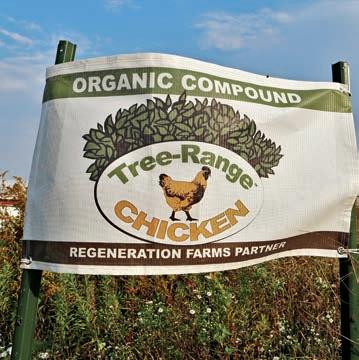
Continued on page 16
PETROLEUM PETROLEUM & NATURAL GAS & NATURAL GAS & NATURAL GAS


Dooley’s Petroleum has been a leading agribusiness energy supplier to the Upper Midwest for over 60 years.
Dooley’s reliable energy supply & expertise to agribusiness offers solutions to address your specific needs.
WILLMAR (CORPORATE OFFICE) 3101 3rd Ave. SW Willmar, MN 56201 Phone: (320) 235-5200 Toll-free: (800) 520-2466
MURDOCK 304 US Hwy 12 Murdock, MN 56271 Phone: (320) 875-2641 Toll-free: (888) 875-2641
CLARA CITY 104 1st Street SW Clara City, MN 56222 Phone: (320) 847-2438
ST. CLOUD 1106 Lincoln Ave Sauk Rapids, MN 56379 Phone: (320)-252-2110
IT’S THE SERVICE THAT SETS US APART!
Continued from page 15
Chickens arrive at the Tree-Range compound farms at 1-day old, and stay four weeks inside of a building. On the fifth week, chickens start rotating in the two outdoor paddocks that each farm has. Rotation is based on how the paddocks regenerate, but chickens always move freely, eating bugs and working the soil.
When Tree-Range birds are adults, they are loaded and sent to a processing facility east of Rochester. But before they are shipped, the birds are prepared a special drink for their last three days containing nonhomogenized vinegar, garlic, onions, sage and Saint-John’s-wort with “a hint of peppermint.”
Haslett-Marroquin gave several reasons for this practice: preflavoring from the sage, peppermint and vinegar; parasite discharge from the garlic and onions; intestine cleanse from the garlic, onion and vinegar; a calming effect from the Saint-John’s-wort, which reduces their appetite when food is cut back before loading.
“Regenerative poultry requires a full connection with the cycles of life. Those connections are what allows us to partake in the cycles of life with spiritual integrity,” HaslettMarroquin said.
Chickens worldwide
Haslett-Marroquin picked chickens as the first livestock to be raised in the regenerative system because he said nowhere in the world prohibits eating them. While cultures throughout the globe forbid eating certain animals such as cows or pigs, chicken soup is the recommended
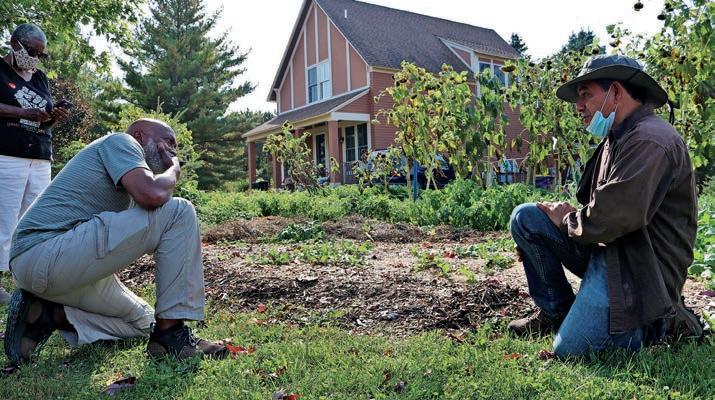
Seitu Jones, co-founder of Frogtown Farms in St. Paul, kneels to be on the same level as Reginaldo HaslettMarroquin, CEO and president of Regenerative Poultry Systems. Marroquin exhibited to the Frogtown directors his patented Tree-Range System for farming poultry. The system restores a jungle-like habitat and brings back native species like hazelnuts and elderberries, which allow the chickens to move freely, eat bugs and work the soil. dish everywhere in the world for people feeling unwell.
“If we are going to make a global impact at a system level, we needed to pick something that is common to everybody,” said Haslett-Marroquin.
Chickens are ideal for the small amount of land at regenerative farms in the system, and compared to the year it takes in producing cows or pigs, the economic cycle in raising chickens is small.
“If you make a mistake (in raising chickens), within 65 days you can correct your mistake,” said HaslettMarroquin. “And you can grow and learn, and do this three or four times a year.”
Haslett-Marroquin said for a big flock, which is about 1,500 chickens, it takes farmers around one and a half hours a day to take care of them. He described taking care of his own flock on just under one acre of land that morning before the tour. He had a 7:30 a.m. meeting on his schedule, and went outside at 7:10 — he harvested feed, brought it to the flock and moved the feeders to a new area, all in 20 minutes.
“I was five minutes late,” he said with a laugh.
Later that afternoon, his daughter took 30 minutes to get the flock new feed and water, and that was all the care the Tree-Range chickens needed for the day, for a total of 50 minutes, said Haslett-Marroquin. That’s not including the 1-2 minutes it took to close the door at night when the chickens had gone inside.
“That is why it’s critical that we systematized and simplified it, so
Your dreams. Your bank.®

When it comes to choosing a banking partner we know you have a lot of choices.
1011 Atlantic Avenue Kerkhoven, MN 56252 320.264.2161 www.financialsecuritybank.com
Terri BarreTT Vice PresidenT BeTh ellioTT loan officer
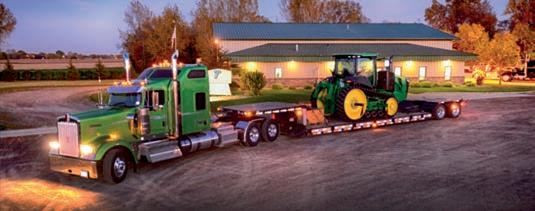
At Financial Security Bank, we work hard to be a different kind of bank. We believe it’s all about relationships... not just accounts. Our staff builds relationships to help you reach your goals!

Tree Range chickens at the farm of Reginaldo Haslett-Marroquin, CEO and president of Regenerative Poultry Systems. that chickens can just be chickens,” If they were to still demand that he Haslett-Marroquin said. “And we stick to the .10 animal units, Haslettdon’t have to do so much work.” Marroquin said he would’ve insisted ‘We have enemies’ Local and state agencies have become more receptive of regenerative agriculture, but that wasn’t the case all the time for Haslett-Marroquin. He’s been farming land in Northfield since 2006 that is considered to be “rural-residential,” they provide him the scientific, agronomic and logical management basis in which they determined it was supposed to be that limit. “I am not violating any of the natural laws, and am actually delivering a much better version of the opening statement in the ordinance,” he said. and county ordinance allows for After all of that, there was still one only .10 animal units per acre to be official in the township that wasn’t raised on it. In the early years, he OK with what he was doing, which was raising more chickens than he Haslett-Marroquin assumed was does now on the site. At a township because he looked different from meeting, his neighbors reported that the farmers the man knew. That Haslett-Marroquin was over the limit individual told him he wasn’t a farmer for animals allowed. He answered because he didn’t have 40 acres. honestly when asked how many Haslett-Marroquin said the chickens were in his flocks. discriminatory and untrue statement
“They were going to shut me only went to motivate his campaign down,” he said. “The sheriff was even more. By that time, he’d met sitting at the meeting.” over 3,000 people in town and
Fortunately he was prepared organized Latino communities in for it. In a 200-plus-page report, Owatonna, Faribault, Winona and he had his entire operation and Red Wing. protocol detailed, with the first line “In Northfield alone, we brought of it reading the local ordinance: “To over 400 families together,” he said. preserve the natural character and “I was sitting at every city council the agricultural vocation.” meeting because I wanted to learn
“I told them, read through that how it worked, and learn how the document, and if you think I’m township worked with the city.” violating the spirit of the ordinance, Denise Mwasyeba, who is on the then we can have a conversation,” board of directors for Frogtown Haslett-Marroquin said. “All I am Farm, said that people of color in doing is exercising my constitutional agriculture and all industries are used right to feed my family.” to encountering naysayers like this.
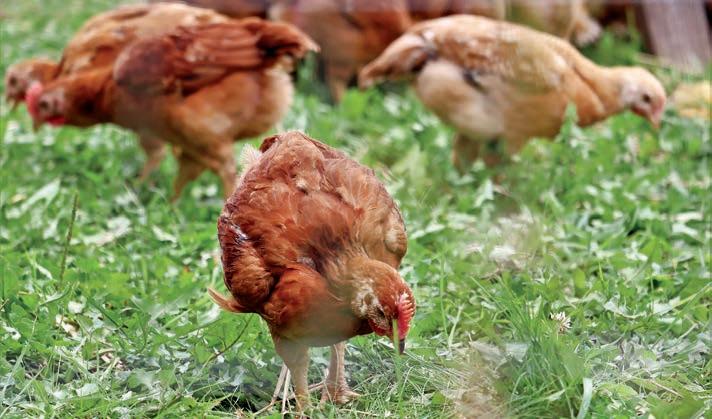
“We have enemies and you have to put on your armor to fight the enemy, because that’s just what’s happening in society,” said Mwasyeba, “I have to throw cold water on myself as I’ve gotten older, because now I get mad, and you can’t do stuff until you calm down and think.”
Seitu Jones, co-founder of Frogtown Farm, said the couple who helped manage their farm the first season faced a similar experience to Haslett-Marroquin. Next to their house in St. Paul, the couple had a hoop house.
“People called and complained to the city, saying if you want a hoop house, you should be out on a farm” said Jones of the couple, who were people of color. “These were complaints from their neighbors.”
That’s why Haslett-Marroquin’s ultimate goal with the project isn’t to make a bundle, but to create a strong alternative to the conventional system which he says “pries and feeds on ignorance and fear.”
“It’s a community-based system because we have to cooperate with others, and with our neighbors, and get to know them,” said HaslettMarroquin. “Be more of a person in the community than an entity that gets in a tractor and goes and does these things.”
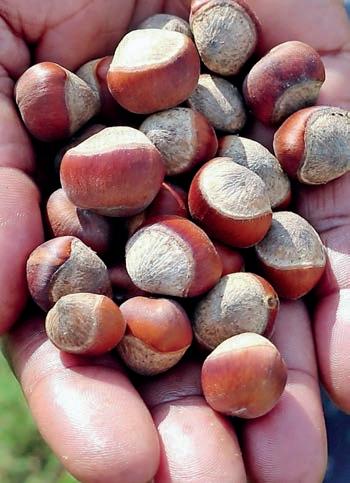
Hazelnuts are used as feed for the Tree Range chickens at the farm of Reginaldo Haslett-Marroquin, CEO and president of Regenerative Poultry Systems.










